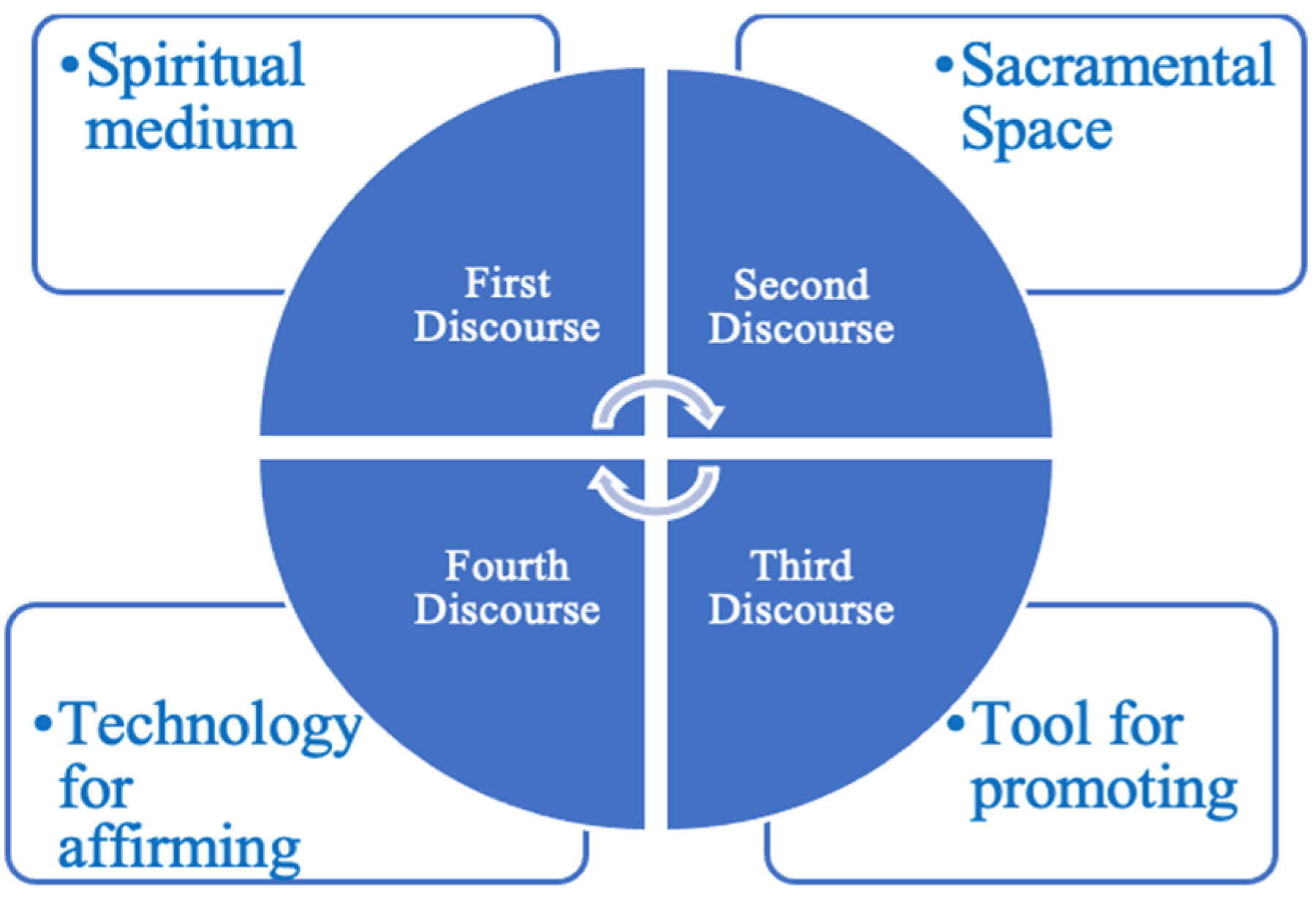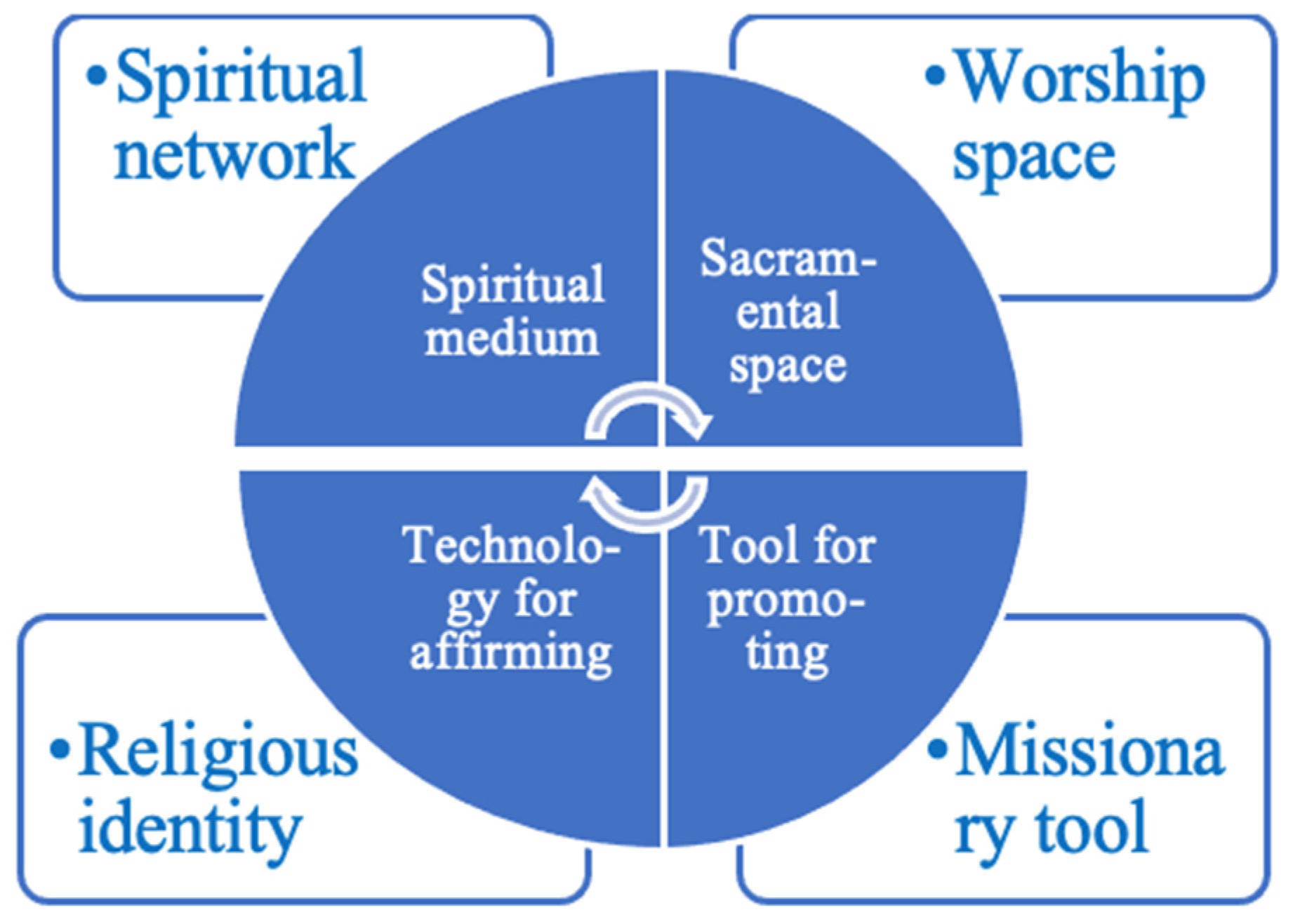Study of the Changing Relationship between Religion and the Digital Continent—In the Context of a COVID-19 Pandemic
Abstract
1. Introduction
2. Overview
Four Paradigms
3. Four Discourses and Four Narratives
Digital Performativity
4. Research Project
4.1. Presentation
4.2. Possible Solutions
5. Religion’s Evolving Relationship to Cyberspace
5.1. Virtual Performativity
5.2. What Type of Shift?
6. Conclusions
Funding
Institutional Review Board Statement
Informed Consent Statement
Conflicts of Interest
References
- Anadón, Marta. 2019. Les méthodes mixtes: Implications pour la recherche « dite » qualitative. Recherches Qualitatives 38: 105–23. [Google Scholar] [CrossRef]
- Bacqué, Marie-Frédérique, and Michel Hanus. 2016. Le deuil, 7th ed. Paris: Presses Universitaires France. [Google Scholar]
- Ben-Cheikh, Imen, Lilyane Rachédi, and Cécile Rousseau. 2020. Deuil compliqué selon les cultures: Défis diagnostiques et limites des classifications internationales. Frontières 32. [Google Scholar] [CrossRef]
- Bratosin, Stefan, Mihaela Tudor, and Iacob Coman. 2010. La pratique du sacré dans le world wide web: Une expérience innovante de la norme. Sciences de la Société 81: 121–34. [Google Scholar] [CrossRef]
- Bunt, Gary R. 2009. IMuslims: Rewiring the House of Islam. Chapel Hill: The University of North Carolina Press. [Google Scholar]
- Campbell, Heidi A. 2005. Spiritualising the Internet. Uncovering Discourses and Narratives of Religious Internet Usage. Online-Heidelberg Journal of Religions on the Internet 1: 1–26. [Google Scholar] [CrossRef]
- Campbell, Heidi A. 2010. When Religion Meets New Media. London and New York: Routledge. [Google Scholar]
- Cobb, Jennifer. 1998. Cybergrace: The Search for God in the Digital World, 1st ed. New York: Crown Publication. [Google Scholar]
- Christensen, Dorthe Refslund, and Stine Gotved. 2015. Online Memorial Culture: An Introduction. New Review of Hypermedia and Multimedia 21: 1–9. [Google Scholar] [CrossRef]
- Depoilly, Séverine, and Séverine Kakpo. 2019. La différenciation Sociale des Enfants Enquêter sur et Dans les Familles. Saint-Denis: Presses Universitaires de Vincennes (Université Paris VIII). Available online: https://go.openathens.net/redirector/umoncton.ca?url=https%3A%2F%2Fwww.cairn.info%2Fla-differenciation-sociale-des-enfants--9782379240379.htm (accessed on 7 September 2021).
- Des Aulniers, Luce. 2007. Pratiques rituelles du temps du mourir et formes actuelles de la belle mort. Frontières 20: 22–26. [Google Scholar] [CrossRef][Green Version]
- Douyère, David. 2015. De la mobilisation de la communication numérique par les religions. Tic&Société 9: 2–27. [Google Scholar] [CrossRef]
- Douyère, David. 2016. Présentation. Tic&Société 9. [Google Scholar] [CrossRef]
- Duteil-Ogata, Fabienne. 2015. New Funeral Practices in Japan. From the Computer-Tomb to the Online Tomb. Online-Heidelberg Journal of Religions on the Internet 8: 11–19. [Google Scholar] [CrossRef]
- Fasse, Léonor, Serge Sultan, and Flahault Cecile. 2013. Expérience de pré-deuil à l’approche du décès de son conjoint: Une analyse phénoménologique interprétative. Psychologie Française 58: 177–94. [Google Scholar] [CrossRef]
- Gauthier, Benoît, and Isabelle Bourgeois. 2016. Recherche Sociale: De la Problématique à la Collecte des Données, 6th ed. Québec: Presses de l’Université du Québec. Available online: http://collections.banq.qc.ca/ark:/52327/2581087 (accessed on 7 September 2021).
- Helland, Christopher. 2005. Online Religion as Lived Religion. Methodological Issues in the Study of Religious Participation on the Internet. Édité par Oliver Krüger. Online-Heidelberg Journal of Religions on the Internet 1. [Google Scholar] [CrossRef]
- Howard, Robert Glenn. 2011. Digital Jesus: The Making of a New Christian Fundamentalist Community on the Internet. New York: NYU Press. [Google Scholar]
- Julliard, André. 2015. La mission d’internationaliser St Nicolas, regards ethnologiques sur le site Stnicholascenter.org de culture religieuse anglicane. In Le Religieux sur Internet. Edited by Fabienne Duteil-Ogata, Isabelle Jonveaux, Liliane Kuczynski and Sophie Nizard. Paris: L’Harmattan, pp. 127–39. [Google Scholar]
- Lövheim, Mia. 2015. Une voix à elles: Jeunes, musulmanes et blogueuses. In Le Religieux sur Internet. Edited by Fabienne Duteil-Ogata, Isabelle Jonveaux, Liliane Kuczynski and Sophie Nizard. Paris: L’Harmattan, pp. 299–30. [Google Scholar]
- Maignant, Catherine. 2017. The ‘Digital Continent’: An Escape Route for a Church in Crisis? Lille: Portail HAL, Université de Lille, pp. 1–18. Available online: https://hal.univ-lille.fr/hal-01651946/document (accessed on 7 September 2021).
- Monbourquette, Jean. 2004. Grandir: Aimer, Perdre et Grandir. Montréal: Novalis. [Google Scholar]
- Monbourquette, Jean, and Isabelle d’Aspremont. 2016. Excusezmoi, je Suis en Deuil: Les Petits Groupes D’endeuillés Remplacerontils les Rituels Funéraires Traditionnels? Montréal: Novalis. [Google Scholar]
- Mottier, Damien. 2015. Le télé-fidèle existetil? Enquête au sein d’une église pentecôtiste de la région parisienne. In Le Religieux sur Internet. Edited by Fabienne Duteil-Ogata, Isabelle Jonveaux, Liliane Kuczynski and Sophie Nizard. Paris: L’Harmattan, pp. 173–87. [Google Scholar]
- Niculescu, Mira. 2015. Se connecter et prendre l’avion. Les réseaux électroniques et physiques de la Jewish Mindfulness. In Le Religieux sur Internet. Edited by Fabienne Duteil-Ogata, Isabelle Jonveaux, Liliane Kuczynski and Sophie Nizard. Paris: L’Harmattan, p. 140. [Google Scholar]
- Paillé, Pierre. 1994. L’analyse par théorisation ancrée. Cahiers de recherche sociologique 23: 147–81. [Google Scholar] [CrossRef]
- Philippe, Aloïse, and Magali Touren-Hamonet. 2021. Deuil anticipé chez les proches et demande d’aide active à mourir venant d’un membre de la famille. Médecine Palliative 20: 271–77. [Google Scholar] [CrossRef]
- Podselver, Laurence. 2015. De la visibilité à la présence virtuelle. Quelques fragments de l’expression du judaïsme sur le Net. In Le Religieux sur Internet. Edited by Fabienne Duteil-Ogata, Isabelle Jonveaux, Liliane Kuczynski and Sophie Nizard. Paris: L’Harmattan, pp. 289–97. [Google Scholar]
- Pope Francis. 2014. Communication at the Service of an Authentic Culture of Encounter [Message of Pope Francis for the 48th World Communications Day]. Available online: http://www.vatican.va/content/francesco/en/messages/communications/documents/papafrancesco_20140124_messaggio-comunicazioni-sociali.html (accessed on 7 September 2021).
- Roy, Olivier. 2000. La communauté virtuelle. L’internet et la déterritorialisation de l’islam. Reseaux 99: 219–37. Available online: https://www.cairn.info/revue-reseaux1-2000-1-page-219.htm?contenu=resume (accessed on 7 September 2021). [CrossRef]
- Stroebe, Margaret, Henk Schut, and Kathrin Boerner. 2017. Cautioning Health-Care Professionals: Bereaved Persons Are Misguided Through the Stages of Grief. OMEGA-Journal of Death and Dying 74: 455–73. [Google Scholar] [CrossRef]
- Thomas, Louis-Vincent. 1991. Mort en Question: Traces de Mort, Mort des Traces. Paris: Harmattan. [Google Scholar]
- Vanel, Chrystal. 2015. Mormonisme et internet, entre promotion institutionnelle et régulation de l’utilisation individuelle. In Le Religieux sur Internet. Edited by Fabienne Duteil-Ogata, Isabelle Jonveaux, Liliane Kuczynski and Sophie Nizard. Paris: L’Harmattan, pp. 275–288e. [Google Scholar]
- Varlik, Selami. 2015. Le discours islamique sur internet: Oralité de l’écriture et fragmentation de l’oralité. In Le Religieux sur Internet. Edited by Fabienne Duteil-Ogata, Isabelle Jonveaux, Liliane Kuczynski and Sophie Nizard. Paris: L’Harmattan, pp. 49–63. [Google Scholar]
- Vekemans, Tine. 2014. Double-Clicking the Temple Bell. Devotional Aspects of Jainism Online. Online-Heidelberg Journal of Religions on the Internet 6: 126–43. [Google Scholar] [CrossRef]
- Wertheim, Margaret. 2000. The Pearly Gates of Cyberspace—A History of Space from Dante to the Internet. Reprint. New York and London: W. W. Norton & Co. [Google Scholar]
- Wheeler, Kayla Renée. 2014. Remixing Images of Islam. The Creation of New Muslim Women Subjectivities on YouTube. Online-Heidelberg Journal of Religions on the Internet 6: 144–63. [Google Scholar] [CrossRef]


| Paradigms | Postures |
|---|---|
| Spiritual network | Exterior posture |
| Worship space | Inner posture |
| Missionary tool | Posture after |
| Religious identity | Front Posture |
| Category 1 | Prayer practices |
| Category 2 | Legalistic practices |
| Category 3 | Religious socialization |
| Category 4 | Knowledge practices |
| Category 5 | Visual and discursive practices |
| Category 6 | Religious action guidance |
| Category 7 | Informational practices |
| Category 8 | Political practices |
| Category 9 | Call to action |
| Questionnaire 3 (Q. 3) Bereaved Families | Telephone Interview (Q. 4) Bereaved Families | ||
|---|---|---|---|
| Area 1 | Helplessness | Area 1 | Helplessness |
| Area 2 | Delayed funeral | Area 2 | Delayed funeral |
| Area 3 | Space where one can be heard | Area 3 | Delayed grief |
| Area 4 | Need to grieve | Area 4 | Social group |
| Area 5 | Funeral rituals | Area 5 | Funeral Rituals |
Publisher’s Note: MDPI stays neutral with regard to jurisdictional claims in published maps and institutional affiliations. |
© 2021 by the author. Licensee MDPI, Basel, Switzerland. This article is an open access article distributed under the terms and conditions of the Creative Commons Attribution (CC BY) license (https://creativecommons.org/licenses/by/4.0/).
Share and Cite
Barreau, J.M. Study of the Changing Relationship between Religion and the Digital Continent—In the Context of a COVID-19 Pandemic. Religions 2021, 12, 736. https://doi.org/10.3390/rel12090736
Barreau JM. Study of the Changing Relationship between Religion and the Digital Continent—In the Context of a COVID-19 Pandemic. Religions. 2021; 12(9):736. https://doi.org/10.3390/rel12090736
Chicago/Turabian StyleBarreau, Jean Marc. 2021. "Study of the Changing Relationship between Religion and the Digital Continent—In the Context of a COVID-19 Pandemic" Religions 12, no. 9: 736. https://doi.org/10.3390/rel12090736
APA StyleBarreau, J. M. (2021). Study of the Changing Relationship between Religion and the Digital Continent—In the Context of a COVID-19 Pandemic. Religions, 12(9), 736. https://doi.org/10.3390/rel12090736





